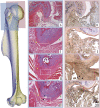Intraarticular injection of relaxin-2 alleviates shoulder arthrofibrosis
- PMID: 31160441
- PMCID: PMC6589647
- DOI: 10.1073/pnas.1900355116
Intraarticular injection of relaxin-2 alleviates shoulder arthrofibrosis
Abstract
Arthrofibrosis is a prevalent condition affecting greater than 5% of the general population and leads to a painful decrease in joint range of motion (ROM) and loss of independence due to pathologic accumulation of periarticular scar tissue. Current treatment options are limited in effectiveness and do not address the underlying cause of the condition: accumulation of fibrotic collagenous tissue. Herein, the naturally occurring peptide hormone relaxin-2 is administered for the treatment of adhesive capsulitis (frozen shoulder) and to restore glenohumeral ROM in shoulder arthrofibrosis. Recombinant human relaxin-2 down-regulates type I collagen and α smooth muscle actin production and increases intracellular cAMP concentration in human fibroblast-like synoviocytes, consistent with a mechanism of extracellular matrix degradation and remodeling. Pharmacokinetic profiling of a bolus administration into the glenohumeral joint space reveals the brief systemic and intraarticular (IA) half-lives of relaxin-2: 0.96 h and 0.62 h, respectively. Furthermore, using an established, immobilization murine model of shoulder arthrofibrosis, multiple IA injections of human relaxin-2 significantly improve ROM, returning it to baseline measurements collected before limb immobilization. This is in contrast to single IA (sIA) or multiple i.v. (mIV) injections of relaxin-2 with which the ROM remains constrained. The histological hallmarks of contracture (e.g., fibrotic adhesions and reduced joint space) are absent in the animals treated with multiple IA injections of relaxin-2 compared with the untreated control and the sIA- and mIV-treated animals. As these findings show, local delivery of relaxin-2 is an innovative treatment of shoulder arthrofibrosis.
Keywords: arthrofibrosis; fibrosis; frozen shoulder; relaxin.
Conflict of interest statement
Conflict of interest statement: M.W.G., E.K.R., and A.N. are coinventors on a patent application submitted to the United States Patent and Trademark Office on the application of human relxin-2 as a treatment for arthrofibrosis.
Figures




References
-
- Vezeridis P. S., Goel D. P., Shah A. A., Sung S. Y., Warner J. J., Postarthroscopic arthrofibrosis of the shoulder. Sports Med. Arthrosc. Rev. 18, 198–206 (2010). - PubMed
-
- DeHaven K. E., Cosgarea A. J., Sebastianelli W. J., Arthrofibrosis of the knee following ligament surgery. Instr. Course Lect. 52, 369–381 (2003). - PubMed
-
- Sharkey P. F., Hozack W. J., Rothman R. H., Shastri S., Jacoby S. M., Insall Award paper. Why are total knee arthroplasties failing today? Clin. Orthop. Relat. Res. 2002, 7–13 (2002). - PubMed
-
- Papagelopoulos P. J., et al. , Complications after tibia plateau fracture surgery. Injury 37, 475–484 (2006). - PubMed
Publication types
MeSH terms
Substances
LinkOut - more resources
Full Text Sources
Other Literature Sources
Medical
Research Materials

